I am not sure anyone else noticed, but a couple of weeks ago, Bethanie Mattek-Sands and Sofia Kenin nearly served out of order at the Italian Open. It occurred in a Round of 16 loss against Elise Mertens and Su Wei Hseih. Down match point in the super breaker, Kenin stepped up to the line when it was Mattek-Sand’s turn to serve.
From the video clip of the incident, it is apparent that the only person on the court who realized that an order of service error was imminent was the chair umpire, who verbally stopped Kenin from serving. This episode made me wonder how frequently this issue occurs in traditional (non-Coman) tie-break games played without the benefit of an official. I suspect that it happens a lot.
This is another argument for universal adaptation of the Coman tie-break game. When the Coman format is used, doubles players exclusively serve from one end throughout each set, including the tie-breaker. That makes it less likely for players to accidentally serve out of order because they would also be serving from the wrong end. Both the serving and receiving teams are much more likely to notice any deviation.
What if the error had actually occurred?
Per the ITF Rules of Tennis, the point would have stood if the umpire had not intervened before Kenin put the ball in play. That is codified in Rule 27.
As a principle, when an error in respect of the Rules of Tennis is discovered, all points previously played shall stand.
ITF Rules of Tennis, Rule 27, Correcting Errors
The match would have been over if Kenin and Mattek-Sands had lost the point after serving out of order. However, had they won it and the error was detected immediately after that point, Mattek-Sands would have served at 10-10. The correction procedures differ depending on whether detection occurred after an even or odd number of points.
If a player serves out of turn during a tie-break game and the error is discovered after an even number of points have been played, the error is corrected immediately. If the error is discovered after an odd number of points have been played, the order of service shall remain as altered.
ITF Rules of Tennis, Rule 27.d, Correcting Errors
This rule’s even/odd aspects are subtly elegant. Every change of server occurs at an odd number of points. If a team notices that their opponents are consecutively sending the same server back to the line, this correction procedure establishes that the other player has to serve as the rotation remains altered going forward.
On the other hand, one weird edge case could potentially arise. If a team serves out of order and three points are played before someone notices that the error occurred, that would put detection on an even number of points. It could be argued that the correction procedure in that case would be to have the player who served out of turn correct the error by once again serving the next two points. I am sure the argument would be epic if that scenario ever transpired.
While I suspect this issue frequently occurs in unofficiated matches where the standard tie-break game is used, I also believe that detection is exceedingly rare. I am willing to wager that many USTA roving officials wouldn’t be confident in how to proceed if a dispute arises.
After writing about the Coman last weekend, it occurred to me that the Kenin/Mattek-Sands episode is another powerful argument for its universal adoption. I think it would be better even for professional tours.
- ITF Rules of Tennis, International Tennis Federation, 2024




But if the detected error in doubles occurs after a point with one of the returners returning from the wrong side? Does the even/odd aspect still apply to returners?
I personally don’t like the Coman and I don’t think one case on the WTA especially when there’s officials is enough to advance it anymore than it already is. Plus, players aren’t necessarily serving from the same side every set either in doubles, so the perceived confusion supposedly limited by the Coman would still exist. I think the Coman is actually more confusing overall with so much more switching going on. Naturally, there seems to confusion sometimes with tiebreaks in general regardless of tiebreak format. Every player should be able to serve from both sides of the court. I don’t think this is a big deal and it’s the same for both teams. It all evens out in the end.
As you intimate, Rule 27 implementation is essentially Greek to players, and only slightly less head scratching (Old English), for officials and requires perpetual review. A move to Coman format would help rectify the obfuscation of the rule. Until then, keeping a copy of FAC in my back pocket while roving does afford some solace.